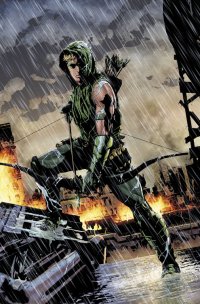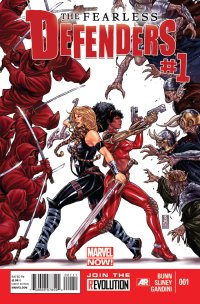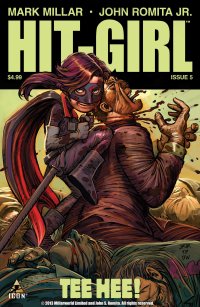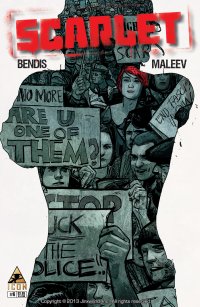Snapshot #1 (Image, $3.99)
By Jeb D.
2012 was not a great year for the legacy of Alfred Hitchcock, as his life and career were the bases of HBO’s unconvincing  The Girl, and the ludicrously overwrought feature film Hitchcock. Maybe 2013 can redeem itself a bit as Andy Diggle and Jock bring the old master’s “ordinary guy involved in bizarre murder” template up to date in the first chapter of a mystery that promises to be satisfying, at best, and with the potential to be even better than that.
The Girl, and the ludicrously overwrought feature film Hitchcock. Maybe 2013 can redeem itself a bit as Andy Diggle and Jock bring the old master’s “ordinary guy involved in bizarre murder” template up to date in the first chapter of a mystery that promises to be satisfying, at best, and with the potential to be even better than that.
(I should probably mention that this comic has already been serialized over in the UK in the pages of Judge Dredd magazine, so its potential has already been realized, or not, for some readers. But not for me yet).
In San Francisco’s Golden Gate Park, comic-store clerk Jake finds an expensive-looking smartphone. When he decides to take a peek at the photos, hoping for some sexy private snaps, he’s confronted with what appears to be evidence of a grisly murder (if I had that sort of pix on my phone, I’d probably password-protect it, but whatever…). And as he and his buddy Steve (a classic Comic Book Guy) try to decide the best course of action, the mystery gets deeper—is there, in fact, a murder? if so, is it even the one it appears to be?— the violence gets brutal and personal, and the final twist of this first issue is even stranger than you’d expect.
I won’t spoil more of the story details, beyond the fact that Diggle does a reasonable job of keeping Jake’s actions, and reactions, plausible, in the face of his increasingly-dangerous circumstances. And in a four-issue series, characterization is necessarily kept basic, but we’re reading for the questions, the answers, and the suspense, not any particular human insights.
The Diggle/Jock team is, of course, self-recommending, even in stark black and white. Not everyone will take to Jock’s minimalist choices here (apart from the inside of the comic shop, backgrounds are nearly nonexistent), but the storytelling is knife-edge sharp and driving (and it’s always nice to see the San Francisco setting depicted as something other than a picture postcard).
There’s kind of an upper ceiling on expectations of a story like this, particularly in four issues: with puzzles nested inside other puzzles, it will be sufficient if Diggle delivers a satisfying set of answers along with the brisk pacing.
Rating: 




Out of a Possible 5 Stars
 Green Arrow #17 ($2.99, DC)
Green Arrow #17 ($2.99, DC)
by D.S. Randlett (@dsrandlett)
Don’t call it a reboot. Sure, the latest issue of Green Arrow features a new creative team, a complete destruction of the series’ old status quo, and a new approach. But don’t call it a reboot.
So it’s been about a year and a half since the New 52, and by most accounts it’s been a disaster. It is now apparent that it was an event driven not by sound narrative or editorial judgment, but by the desire of Bob Harras and Dan Didio to keep their jobs. One need only look at the Superman line for a perfect encapsulation of everything that has gone wrong at the venerable-ish publisher. Constant creative team upheavals, rushed writing and art, no cohesive narrative vision. One should expect better from the caretakers of some of the most beloved characters of all time. It is, however, also apparent that there are some really interesting things happening on the margins of the New 52, with their “Dark” line and Jeff Lemire leading the way with titles like Animal Man and Justice League Dark, which actually feel like fun stories with narrative purpose rather than poorly thought out “reinventions” of popular characters meant to help Dan Didio point to a balance sheet. To date, Lemire’s work at DC has been weird, fun, and cool, all while retaining a sense of drive and character.
So here we have Lemire and Andrea Sorrentino, another “Dark” line alumnus, coming to the rescue of one of the mainline DCU’s minor mainstays, Green Arrow. Besides the O’Neill/Adams Green Lantern/Green Arrow run and his longtime presence in various incarnations of the Justice League, I’ve never really made an effort to get into the character. The New 52 version didn’t do much to sway me, either. I always appreciated GA as a sort of father figure, but here he was in a guise much like his pre Denny O’Neill incarnation. He was always a cocky guy, but that aspect of his character was counterbalanced by his social consciousness and a good nature. At the start, the New 52’s version of Oliver Queen just came off as cocky, reinvisioned as sort of superheroic Steve Jobs. Which basically boils down to a guy with gadgets, and in this case a gimmick. I realize that sometimes superheroes need to “get back to their roots” sometimes, but is a Batman rip-off with a cornier gimmick really a character with roots worth getting back to?
In some interviews, Lemire has said that he was never a fan of the character, but was inspired by Mike Grell’s run with the character and Brian Michael Bendis’ run on Daredevil. This issue is basically Lemire tearing down Green Arrow/Oliver Queen’s entire world. His role in his father’s corporation and his fortune? Gone. His old support staff? Gone. This all happens in this issue’s first 3 or 4 pages in a story that moves at breakneck pace, and introduces some intriguing new characters and a sense of mystery, all while keeping the action fast, gritty, and high octane.
Since spending some time with Sorrentino’s art on I, Vampire, I’ve always thought that he was a good artist. But when it was announced that he would be working on this series, I wasn’t sure what to think, as I associated his style with horror rather than with urban vigilantes. He does acquit himself rather well here, experimenting with color in fun ways. For example, everything that Green Arrow touches in a combat context turns green, effectively making it an extension of the character. Impacts are also highlighted by their own panels within the context of a larger action panel, which serves two functions. One, it’s an insight into how Queen sees his surroundings during combat, with objects becoming targets for action. Two, it gives the action a real sense of impact and choreography. In superhero comics we usually see poses rather than action, but Sorrentino gives the action here a feeling of sharp and direct impact, which gives the book its sense of propulsion. It’s rare that you see an artist shape a script like Sorrentino does here, particularly in the superhero genre.
What’s most refreshing here is what Lemire and Sorrentino do with the status quo, not just specific to Green Arrow, but as a genre trope. Usually the first issue of a new run introduces us to new players, and they all have obvious roles. Ongoing fiction usually unfolds like a sort of game, with characters conforming to certain sets of rules. The superhero genre particularly leans on this, mostly because it’s a good way to maintain familiarity with a readership that’s constantly in flux. The first issue of this new run of Green Arrow seems to be saying, in effect, there is no status quo, characters are expendable. I don’t know how long this series is going to stay on edge like this, but for now Green Arrow proves to be an exhilarating read.
Rating: 




Out of a Possible 5 Stars
Scarlet #6 (Icon, $3.95)
Fearless Defenders #1 (Marvel, $3.99)
Hit-Girl #5 (Icon, $4.99)
The return of Brian Bendis and Alex Maleev’s Scarlet is kind of a mixed blessing. Obviously, it’s always great to see two of today’s top creators turned loose to do their own thing, but the almost two-year lag time since the previous issue has taken some of the edge from storytelling that needed to be pretty breathless. Too, world events have a way of moving on with no regard to the sensitivities of comic-book creators, and the post-Occupy world that this issue takes place in (and which Bendis acknowledges in the backmatter) has already seen some of the awakening that Scarlet and her acolytes are trying to bring about: I suppose one could view that as prescience, but the contrast with the way these things actually happen does somewhat undercut the “reality” of this comic.
For those who haven’t been following the series, Scarlet Rue is a young Portlander whose boyfriend died at the hands of corrupt policemen, protecting a corrupt system, and who has channeled her anger into revolutionary fervor and crowd-sourced action. In this issue, we pick up in the wake of the grenade attack in issue #5, and Scarlet re-emerges, confronting authority even more directly than before, with time taken to begin fleshing out the supporting cast.
I have to admit that I’d rather hoped to see this series move down a less garish and obvious path (the real danger to our liberties comes from corruption that’s too smart to simply gun down smalltime drug dealers on the street), but Bendis and Maleev make the events feel grounded and at least somewhat plausible.
While there is a world of difference between the mostly nonviolent protests of Occupy, and the gun-wielding revolutionaries of Scarlet, there’s no question that we’ve seen enough mass protest on our televisions in recent months, both here and abroad, that the relative unreality of the situations in this issue feel awkwardly over-the-top, when the previous issues seemed more like a slightly-exaggerated next step. Scarlet herself is an interestingly conceived character: she’s one of Bendis’ strong, smart-mouthed, women, but there’s no Jessica Jones-style nurturing; think Deena Pilgrim with an even colder sense of righteous anger. Bendis and Maleev ratchet up the tension as Scarlet and her supporters take over a TV station at gunpoint, and while I wouldn’t recommend new readers begin reading the series here, anyone who’s been onboard up to this point will appreciate the increased intensity, even if some plausibility is lost.
The freedom of shedding the superhero straitjacket is felt in the way Bendis and Maleev shake up the storytelling, in things like the fourth-wall-breaking blackout pages, and the Hickman-like choice to intersperse bits of the sequential narrative with static text-and-picture pages out of a rather grim children’s book. Maleev’s photo-referencing is, by now, something that comics readers either accept or reject: if you’re a fan, it’s typically good, though not his most challenging piece of visual storytelling.
I still think that Scarlet would have worked better as a quick-hitting mini or OGN, but if you don’t find the storytelling too stretched out, this is a strong, provocative chapter.
 It’s always nice when a comic can work interesting twists on familiar tropes. In the case of the new Fearless Defenders, it looks as though writer Cullen Bunn is playing variations on the mismatched buddy-cop premise, pairing the streetwise, bionically-enhanced Misty Knight with Asgard’s high-flying Valkyrie, in the debut of a series that will evidently feature a shifting (rather than rotating) cast of female heroes, taking on such charmingly outre baddies as a pack of zombie Vikings. While other familiar Marvel heroines are slated to appear in future issues, it appears that the team will be anchored by “the smart one” (she wears glasses, you see), archaeologist (“she grew up watching a lot of Indiana Jones“), Dr. Annabelle Riggs.
It’s always nice when a comic can work interesting twists on familiar tropes. In the case of the new Fearless Defenders, it looks as though writer Cullen Bunn is playing variations on the mismatched buddy-cop premise, pairing the streetwise, bionically-enhanced Misty Knight with Asgard’s high-flying Valkyrie, in the debut of a series that will evidently feature a shifting (rather than rotating) cast of female heroes, taking on such charmingly outre baddies as a pack of zombie Vikings. While other familiar Marvel heroines are slated to appear in future issues, it appears that the team will be anchored by “the smart one” (she wears glasses, you see), archaeologist (“she grew up watching a lot of Indiana Jones“), Dr. Annabelle Riggs.
It’s a fine concept structurally: Marvel has plenty of female B- and C-list characters who may fare better in small doses here and there than having to shoulder the burden of an ongoing series, and this first team-up comes off very well, with weird mystery, fun banter, and some kick-ass mayhem.
Which is why I really wish I could recommend the series more highly, but for all its strengths, it feels as though it’s selling itself to the fanboy market in ways that undercut the value of having a female-centric superhero series in the first place.
Artist Will Sliney, with colorist Veronica Gandini, delivers well-paced action, nice splashes, and his facial work is strong and consistent. His touch is so assured, though, that his constant choice to depict Misty in clichéd exaggerated butt-shots and weirdly suggestive poses can’t be anything but deliberate pandering. More worrying, because it’s part of the script, is the choice to introduce Dr. Riggs’ lesbianism by having her jump up and plant a huge kiss on the lips of the statuesque Valkyrie, whom she’s only just met. It’s not only cheesy and obvious (we even get a narrative box over that panel: “Dr. Annabelle Riggs. Likes girls.“), but it’s particularly disappointing given the intelligent and emotionally satisfying way Marvel has allowed same-sex relationships to grow and develop in series like Young Avengers and Astonishing X-Men: here, it’s just quick, hot girl-girl liplock, presented with all the subtlety of a superhero haymaker.
I’m going to try and cut this book some slack: the lurching forward of Marvel’s new Disney-driven reach for female readers has produced its awkward moments (like the recent announcement of these mind-bogglingly odd young-adult “superheroine chick-lit” novels), but it’s a worthwhile goal. If the touches of sexism in this first issue of Fearless Defenders are just the creative team’s growing pains with the concept, we might have a solidly entertaining female-focused teamup book on our hands here.
And then there’s Hit-Girl. In the Kick-Ass film, Matthew Vaughn and Chloe Grace Moretz made Hit-Girl such an 
engaging, memorable character, that their work casts a warm glow over my anticipation of every new comic from the “Kick-Ass verse”… an anticipation that is invariably doused with cold water every time I read an actual comic.
This is the concluding issue of the miniseries that takes place in between the first two Kick-Ass minis. Given its prequel-like positioning, there was pretty much no chance that writer Mark Millar would come up with any particularly interesting plot twists or payoffs, since we already know “what happens next,” so he settles for giving John Romita Jr. and inker Tom Palmer more opportunities for the depiction of bloody mayhem. They excel at this, of course, but there’s nothing of the kinetic fun that Hit-Girl can deliver at her best (and which made the film version so effective): we mostly see the bloody aftermath of her dispatching the bad guys who threatened her new family (who, we will note, are still alive when Kick-Ass 2 begins, so not much in the way of suspense): pages and panels full of dead mafiosi, with the occasional close shot of a handgun execution. One could argue, I suppose, that taking the cathartic fun out of violence allows a creator to ponder the dark reality at the heart of it, but not even Millar thinks that’s what he’s doing here.
It’s not news that Millar is happy to celebrate the ugliness of exaggerated violence in his work, but at least when he was playing in the regular Marvel sandbox, there was propulsive forward motion: the Kick-Ass books (and other Millarworld titles like Wanted or Nemesis) seem satisfied with just the ugliness.
Scarlet #6: Rating: 




Out of a Possible 5 Stars
Fearless Defenders #1: [Rating 3.0]
Hit-Girl #5: Rating: 




Out of a Possible 5 Stars
